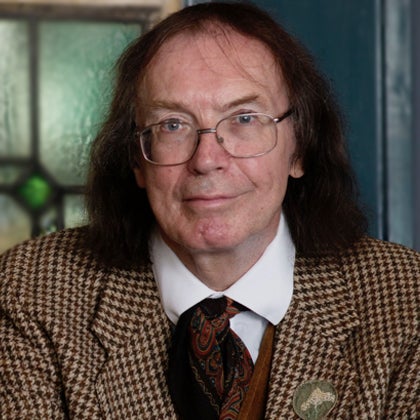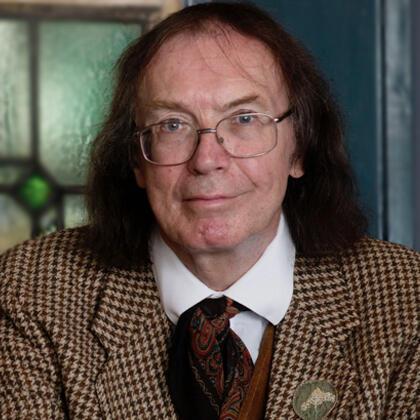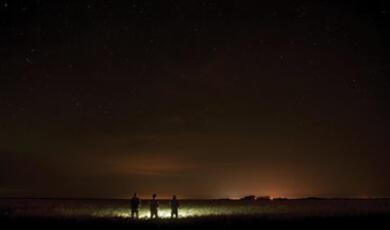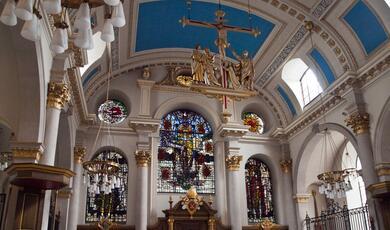Ritual Nudity in History and Religion
Share
- Details
- Text
- Audio
- Downloads
- Extra Reading
This lecture looks at the role played by nudity in European religion and magic from ancient times to the present, with some reference to a global context.
It reveals the unexpected pattern and explains why it has been marginal to religion, except in initiation ceremonies, but very important in magical practices.
Download Text
Ritual Nudity in History and Religion
Professor Ronald Hutton
6 March 2024
The Starting Point
In a book I published in 1991, on the pagan religions of ancient Britain, I drew a number of parallels between those religions and the modern pagan one known as Wicca. I did not question Wicca’s status as a viable current religion but suggested that as a modern belief system it had certain differences from its ancient forerunners. One was that many Wiccans regularly conducted their rites in the nude, which no known cult did in the ancient world. The whole of this talk really consists of a series of reflections on that conclusion. In one sense it remains true, but in another it was wholly inadequate as a consideration of its subject. A better one may start by looking at the place that such nudity holds in Wicca.
The Case of Wicca
Wiccans themselves have traditionally justified the use of nudity in ritual by claiming that it releases a natural field of magical energy from the body and also enhances a sense of equality in a Wiccan group. Neither seems satisfying. The claim of magical bodily energy has no objective evidence to uphold it and disparages the large number of ceremonial magicians, throughout history, who have worked clothed. As for equality, Wiccan groups are often run by one or two people and operate a hierarchy of status. I would propose instead that nudity has two practical benefits for them. One is that it powerfully reinforces the sense that a Wiccan ceremony is a place set dramatically apart from the everyday world. The other is that it demands a high degree of trust and harmony within a group, and tests it for those qualities.
None of these considerations, however, explain why ritual nudity was present in Wicca in the first place. It is significant that it reflected the tastes of the religion’s probable founder, Gerald Gardner, a keen naturist who was convinced of the medical, social, and magical virtues of nudity. More generally, however, it was part of a package which made Wicca a powerfully counter-cultural mystery religion. That religion valued precisely those phenomena which society had traditionally feared or subordinated: the night, the moon, the feminine, magic, wild nature, paganism and the figure of the witch. As part of this process, it turned nudity, commonly used in Western culture to represent shame and weakness, into a motif of confidence and power. But did this symbolism have ancient roots?
The Ancient Context
The General Picture
There is little scholarly literature with which to answer this question, the main book on ancient ritual nudity having been the work of a German writing in Latin and published in 1911. It is true that artwork across ancient Europe and the Near East shows a lot of naked people, but these are mostly deities, heroes, and nymphs, portrayed as such to distinguish them from ordinary humans. Rulers of Sumerian city-states were sometimes shown kneeling unclothed before a deity, but that may have been an artistic expression of humility.
Overall, there is no unequivocal evidence that any ancient religion of the European and Near Eastern world held rites in which even one or two nude people had a regular place. Even the young men who ran around ancient Rome in the Lupercalia festival, sometimes described as unclothed, wore leather jockstraps. Where stark nudity is described in a ceremony, it is associated with special rites of passage, such as the naked man who lit a funeral pyre in Ibn Fadlan’s description of pagan Russia in the 920s. He also walked backwards, further setting him apart from normal humanity. However, this summary misses out an important area in which ritual nudity had a regular part: initiation into mystery religions.
The Mystery Religions
There is good evidence that in some of these religions, closed societies devoted to the worship of one or two particular deities, the initiate was stripped naked and reclothed as part of acceptance into the cult. This is a clear metaphor for rebirth. Some of the apparent references to the process in these kinds of religion could indeed be metaphors in themselves, describing a spiritual rather than a physical unclothing and reclothing. Where nudity is shown in paintings associated with mystery cults, it may be part of mythological rather than actual scenes. Nevertheless, there are two good pieces of evidence for the real employment of it. One is a series of wall-paintings at Capua in Italy, showing a seemingly real initiation into the mystery religion of the god Mithras. In every one the initiate is naked, bound and blindfolded and the initiator clothed.
The other piece of evidence consists of ancient Judaic and Christian baptism. Contemporary testimony suggests strongly that converts to Judaism were baptised nude and makes it certain that Christians were, in a private ceremony held by initiates. The postulant undressed, was anointed with oil at several points of the body, bathed in water, and was reclad in white. A female postulant was supposed to be anointed by a fellow woman, but if none were available then a priest had to do it. It is hard to imagine that such a custom would have been incorporated into a religion which generally loathed nudity as much as early Christianity were it not regarded as an indispensable aspect of initiation into a mystery faith.
All this seems to be suggesting that ritual nudity had a place in ancient European and Near Eastern religion at certain key moments of transformation, but that any other role for it is unproven and it vanished from the Western religious tradition at the end of antiquity. Any such conclusion, however, ignores the alleged association between mixed-sex nude rites and Christian heresy.
Christian Heresies
Such rites were a recurrent theme of denunciations by orthodox churchmen of deviant forms of Christianity from the second to the seventeenth centuries. It was not a common theme. Heretics were mostly accused of worse things, such as devil-worship, cannibalism, sexual orgies, incest, and child sacrifice. The evidence for any of this behaviour is, however, supported neither by writings of the unorthodox themselves or by confessions produced by them under interrogation. Instead, it invariably consists of accusations made by churchmen determined to smear the reputation of heresies, without any apparent first-hand knowledge of them. A list of ancient sects were duly accused of ritual nudity as a result, such as the Adamni, Priscillianists, Naasenes and Barbelo Gnostics. After that there is a gap of almost a thousand years, but in the fourteenth century the Turlupins in France and the Men of Intelligence in Flanders were denounced in the same manner.
The most notorious of the holy naturists of the Middle Ages were the Adamites of Bohemia, who appeared in 1420 and denied the validity of the Catholic mass. Their enemies declared that some of them undressed in natural surroundings to reproduce the primal innocence of Eden. The truth is unknown, and they were rapidly wiped out. Nevertheless, for the next four centuries, the Adamites were the classic naked worshippers of the orthodox Christian imagination, represented as a classic example of the bad consequences of religious toleration. They featured as such in the English Revolution of the 1640s, with reports that they were meeting in London parks: but none were apprehended, and the references seem to have been journalistic fictions.
The whole catalogue of Christian heresy, therefore, proves that ritual nudity was an occasional charge used by the orthodox against their enemies, but not that any of those enemies ever actually practised it.
European Witchcraft Beliefs
It is not surprising, therefore, that it became associated with the de luxe heresy of later medieval and early modern Europe, the reputed anti-religion of witches worshipping the Devil, which some churchmen and magistrates imagined from the 1420s onward. It was not however made by the demonologists who wrote about this fictitious witch religion over the next three hundred years. Nor does it feature much in the confessions made by alleged witches. Interestingly, when it does, it echoes the ancient tradition of initiation into mysteries, being said to have occurred when pledging allegiance to Satan.
By contrast, the nudity of witches is a very prominent feature of the art of the early modern period, especially that of northern Europe, and above all of the Germans. From the opening of the sixteenth century onward, artists regularly portrayed witches as casting spells and attending gatherings unclad. This may have been a reflection of the fact that to do so emphasised at a glance their essential depravity and transgressiveness. It may be more important, however, that to portray witches was one of the very few acceptable ways in which artists in Protestant Germany in particular could represent the female nude. The first artist to do so, Albrecht Dürer, actually used poses drawn from depictions of pagan goddesses, who were not fit subjects in the northern Protestant world. Witches took their place.
There is a slight possibility that witches and nudity were rooted in popular tradition, because the only occasions on which they are connected in learned demonologies is in anecdotes reported by common people. These always concern witches travelling to and from their gatherings. It is possible that this is because they were supposed to gain the ability to fly to these by rubbing an ointment onto their bare bodies. Whatever its origins and reason, the artistic tradition of the nude witch became established and persistent, and still appears at the present day.
The question of whether early modern witches actually worked naked is rendered a non-sequitur by the total absence of evidence for any actual witch religion in the period. The satanic cult of the demonologists seems to have been a complete fantasy. The one possible emergence into reality seems to be the Affair of the Poisons in late seventeenth-century France, in which the king’s mistress allegedly allowed a Black Mass to be performed over her naked body to secure power over her royal lover. The truth of this matter, however, may never be established.
The only text before the twentieth century, in fact, which makes nudity a general rule for witches at their gatherings is both very late and unique, Charles Godfrey Leland’s Aradia from 1899. This states unequivocally and famously of Italian witches that ‘as a sign that ye are truly free, ye shall be naked in your rites, men and women also’. It is however notoriously hard to determine whether Aradia reflects a genuine peasant belief, let alone a genuine witch religion. It cannot therefore be used as conclusive evidence.
The Extra-European World
Across the rest of the globe the ancient European pattern seems to be reproduced: ritual nudity is restricted to exceptional moments or to special individuals playing particular roles. The nakedness of Indian fakirs set them apart from the conventional human world and should perhaps be termed symbolic rather than ritual nudity. Two naked men, personifying spirits, presided over sacrificial rites among the coastal tribes of British Columbia. In Samoa, a sacred virgin would appear nude at the rite by which she made the transition to a married woman. In the Marquesa Islands, women danced naked at the funeral of a chief, apparently as representations of life. In southern India, until recently, people would run a few miles nude to the temples of the goddess Renukamba as an ordeal to fulfill a vow or obtain a wish.
The pattern established before seems therefore to hold in world religion: no certain historical examples of religious traditions practised by worshippers of both sexes regularly meeting in the nude. It might be concluded therefore that Wicca has boldly gone where none have gone before, either by taking a Christian stereotype of transgression and giving it positive connotations or by investing all its workings with the intensity commonly associated with rites of passage, or both. To draw that conclusion, however, would be to miss an entire dimension of the subject.
Global Witchcraft Beliefs
In every inhabited continent of the world there are peoples who have believed in the figure to which the English traditionally give the name of witch. In this context it defines a human being who works secret and malevolent magic against other members of the same community, in a hidden tradition passed on by inheritance, initiation or contact with evil powers. All over the world, likewise, peoples who have believed in this figure have also commonly believed that witches work naked.
This is found all over eastern Africa from Kenya to the Transvaal. Anthropologists studying this region have sometimes suggested a practical explanation: that the tribal peoples concerned usually slept naked, and witches would leave their beds like that to travel at night. Other aspects of the stereotype, however, favour a less functional interpretation. The witches concerned are also believed to ride on baboons or hyenas, walk on their hands, paint their black skins white, and eat corpses. All these imagined actions are reversals of accepted human behaviour, and the nudity of witches, in societies in which social nudity is unacceptable, represents the same effect at work.
Witches are also customarily regarded as operating at night and naked among the Trobriand islanders of Melanesia, the Navaho of the south-western United States, the Arabs, and many of the peoples of India. Even in freezing north-east Siberia, among the Chukchi people who had shamans to perform magic, a shaman wanting to utter a curse was expected to perform naked and in the moonlight. Healing operations, by contrast, were performed indoors in special clothing. Once again it seems that Wicca has taken a traditional belief, this time worldwide in its range, and invested it with positive instead of negative connotations, so making it a counter-cultural religion par excellence. Once more, such a conclusion would be premature, and it is necessary to take another sideways step, this time into the realm of ceremonial magic.
Ritual Magic
Here I make a traditional distinction between religion and magic, formulated by the ancient Greeks and built into Western culture ever since. In religion, humans are essentially supplicants, asking the divine for favours and then dependent on its will for results. In magic, humans have some operative control over the result, at least by an arcane understanding of the natural world and at most by compelling superhuman powers. The two operate on a spectrum rather than as entirely separate categories, and neither should be taken automatically as inferior to the other.
Acts of magic represent ritual applied to special and extraordinary occasions, requiring a shift of consciousness or a redefinition of being, every bit as much as rites of passage. It is not surprising, therefore, that nudity plays a prominent part in them. It is found in the Bible, where a king, Saul, and a prophet, Ezekiel, remove their clothing in order to gain the gift of second sight. In ancient Greek and Roman literature certain herbs are to be picked by a naked person operating at night. In medieval and early modern Europe, nudity was especially employed by young women in solitary spells to win a husband or learn the identity of a future one. It is not very surprising, therefore, that when nudity does feature in the confessions of people accused of witchcraft in this period, it is almost always in descriptions of solitary spell-casting. In the European folklore collections of the past two centuries, it remains prominent in solitary magical acts by young women interested in their marital prospects. Sometimes it featured in collective acts for other purposes such as the floating of a harrow in a brook at night by a group of naked women to bring rain during a drought.
Finally, such associations are also found in the extra-European world. In Bengal drought was said to be ended by a nude woman dragging a plough across a field after dark. In Peru and Indonesia, men and boys assembled naked in plantations at night, for races or incantations to encourage the crops. The Pondo of South Africa undressed to protect their homes with a spell against lightning. Different symbolic systems may be operating across these examples: in some, the association of nudity with sex and fertility may be paramount. Even there, however, the general sense of an empowerment of an ordinary human being by the act of removing the garments by which she or he is usually recognised and familiar, seems apparent.
Conclusion
In this perspective, therefore, the place of nudity in Wicca is dependent not so much on its character as a counter-cultural religion, important though that is, as on its character as a magical religion. It consistently dissolves the traditional European distinction between religion and magic. In this perspective it must be significant that the only other religion in which the whole group of participants seems actually to have regularly operated naked is another example of one blended with magical practices. This consisted of some historic forms of Voodoo. A detailed account of the regular Midsummer Night rituals of the famous voodoo queen Marie Laveau Glapion, held in Louisiana in 1872, shows the entire assembly undressed.
Wicca is then not unique in this regard, though it is unusual. What I hope to have suggested this evening is that in having this characteristic it is responding not merely to the views of one man, or to certain functional benefits, or even to the impulse to challenge cultural norms in a modern or postmodern context. It is, rather, in a tradition of magical activity which is not merely ancient, but virtually worldwide.
© Professor Ronald Hutton, 2024
References and Further Reading
Hutton, Ronald. Witches, Druids and King Arthur. 2003.
Miles, Margaret. Carnal Knowing. 1989.
Clark, Kenneth. The Nude. 1956.
© Professor Ronald Hutton, 2024
References and Further Reading
Hutton, Ronald. Witches, Druids and King Arthur. 2003.
Miles, Margaret. Carnal Knowing. 1989.
Clark, Kenneth. The Nude. 1956.
This event was on Wed, 06 Mar 2024
Support Gresham
Gresham College has offered an outstanding education to the public free of charge for over 400 years. Today, Gresham College plays an important role in fostering a love of learning and a greater understanding of ourselves and the world around us. Your donation will help to widen our reach and to broaden our audience, allowing more people to benefit from a high-quality education from some of the brightest minds.


 Login
Login







